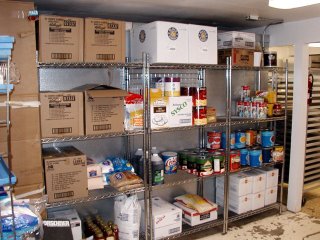 We live in an age where it's possible to buy ready-made meals for the camp kitchen. Given an unlimited food service budget, you could equip the kitchen with a convection oven, sink and freezer. One cook could prepare 150 meals three times each day with little thought given to how each dish was cooked.
We live in an age where it's possible to buy ready-made meals for the camp kitchen. Given an unlimited food service budget, you could equip the kitchen with a convection oven, sink and freezer. One cook could prepare 150 meals three times each day with little thought given to how each dish was cooked.This scenario isn't new. The U.S. Army introduced its T-Ration in the years leading up to the Gulf War. And in recent years, the U.S. Navy has been working on its Advanced Foods option for shipboard food service. These systems are designed to simplify training, reduce labor needs and simplify logistics.
While this idea may appeal from a management point-of-view, it's a costly alternative that few camps can afford. I raise the all-frozen meal alternative only to illustrate this point: That it's possible to cook quality camp meals by finding a balance between scratch-based cooking and purchasing ready-to-use food products for the menu.
The five-year camp menu development project
The FC Camp menu has slowly evolved over the last five years. It's been my long-term culinary project, if you will. What started as a traditional menu with a made-from-scratch focus has slowly turned into a menu where purchased foods compliment kitchen-prepared menu items.
 This approach has worked well for the camp. It balances the need for experienced cooks with the reality of using volunteer labor. Most of the cooks at the Northern California FC Camp bring little commercial food service experience to the kitchen. This isn't a criticism -- it's the simple truth of relying on volunteers to staff a camp kitchen.
This approach has worked well for the camp. It balances the need for experienced cooks with the reality of using volunteer labor. Most of the cooks at the Northern California FC Camp bring little commercial food service experience to the kitchen. This isn't a criticism -- it's the simple truth of relying on volunteers to staff a camp kitchen.A scratched-based menu requires more experience that I have found in the volunteers. (I should note that the food service staff at FC Camp are among the hardest workers I've seen.) I found in my first year that my presence was required in the camp kitchen 12 to 15 hours. As the chief cook for the camp, I brought some 80 percent of the culinary know how to the kitchen.
Each cook and dining room worker contributed varying abilities. My sous chef -- and second in charge -- had the most experience. A decade in school food service gave her the ability to comfortably navigate a commercial kitchen. She was a blessing.
The remaining cooks and dining room workers mostly brought home cooking experience to the kitchen. The hardest worker of them all -- and the daughter of my sous chef -- was the hardest worker of them all. Assigned as the dining room host for the five years now, she's a natural with the kids. And she has the uncanny ability to get each organized in the dining room.
 I found that a willingness to learn and work hard were much more valuable than years of food service experience. (See my index of lessons from a week-long children's Bible camp kitchen for more thoughts on my philosophy.)
I found that a willingness to learn and work hard were much more valuable than years of food service experience. (See my index of lessons from a week-long children's Bible camp kitchen for more thoughts on my philosophy.)Two lessons emerged after that first year: First, if I was to keep my sanity (and keep my work- day under 12 hours), I had to train my staff. I also had to provide a pleasant work environment for the staff. After all, most of us are using vacation time from work. By year two, I was able to let go of some of my cooking duties and focus on leadership.
But I now believe the most important lesson was the realization that I had to change my menu writing ways if I was to keep year-to-year turnover to a minimum.
To be continued ...


No comments:
Post a Comment